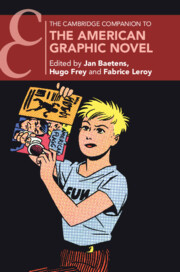Book contents
- The Cambridge Companion to the American Graphic Novel
- The Cambridge Companion to the American Graphic Novel
- Copyright page
- Contents
- Figures
- Contributors
- Editors’ Acknowledgments
- Introduction
- Part I History and Genre
- 1 The “First” Graphic Novel in America
- 2 The Mad-Men Generation
- 3 From Justin Green and Art Spiegelman to Alison Bechdel
- 4 Graphic Journalism
- 5 “Great” American Graphic Novels
- 6 Crime
- 7 Superheroes in Graphic Novels
- 8 Science Fiction and Fantasy
- 9 “Scared Witless”
- Part II Graphic Novels and the Quest for an American Diversity
- Index
- Cambridge Companions To …
- References
5 - “Great” American Graphic Novels
Canon Formation and Literary Value
from Part I - History and Genre
Published online by Cambridge University Press: 10 January 2024
- The Cambridge Companion to the American Graphic Novel
- The Cambridge Companion to the American Graphic Novel
- Copyright page
- Contents
- Figures
- Contributors
- Editors’ Acknowledgments
- Introduction
- Part I History and Genre
- 1 The “First” Graphic Novel in America
- 2 The Mad-Men Generation
- 3 From Justin Green and Art Spiegelman to Alison Bechdel
- 4 Graphic Journalism
- 5 “Great” American Graphic Novels
- 6 Crime
- 7 Superheroes in Graphic Novels
- 8 Science Fiction and Fantasy
- 9 “Scared Witless”
- Part II Graphic Novels and the Quest for an American Diversity
- Index
- Cambridge Companions To …
- References
Summary
This chapter addresses the graphic novel as a new form of the “Great American Novel” (GAN). This possibility is seen as the result of two interacting processes: canon formation (Which are the graphic novels that can gain inclusion into the mainstream canon?), and literary validation (Can graphic novels be judged with the same criteria as literary novels?). The chapter discusses the critical debates on the recognition of comics as a form of literature and the role of academia and other institutions in the making of a graphic novel canon. It studies the progressive literarification of comics and graphic novels, before focusing on the notion of the GAN, a label that refers to works picturing the ordinary emotions and manners of American existence (J. W. DeForrest), preferably with a high degree of realism. The chapter critically discusses this notion and concludes with a close reading of four graphic novels that constitute good candidates for the title of GAN: Ghost World, Fun Home, American Born Chinese, and Asterios Polyp.
Keywords
- Type
- Chapter
- Information
- The Cambridge Companion to the American Graphic Novel , pp. 89 - 105Publisher: Cambridge University PressPrint publication year: 2023

